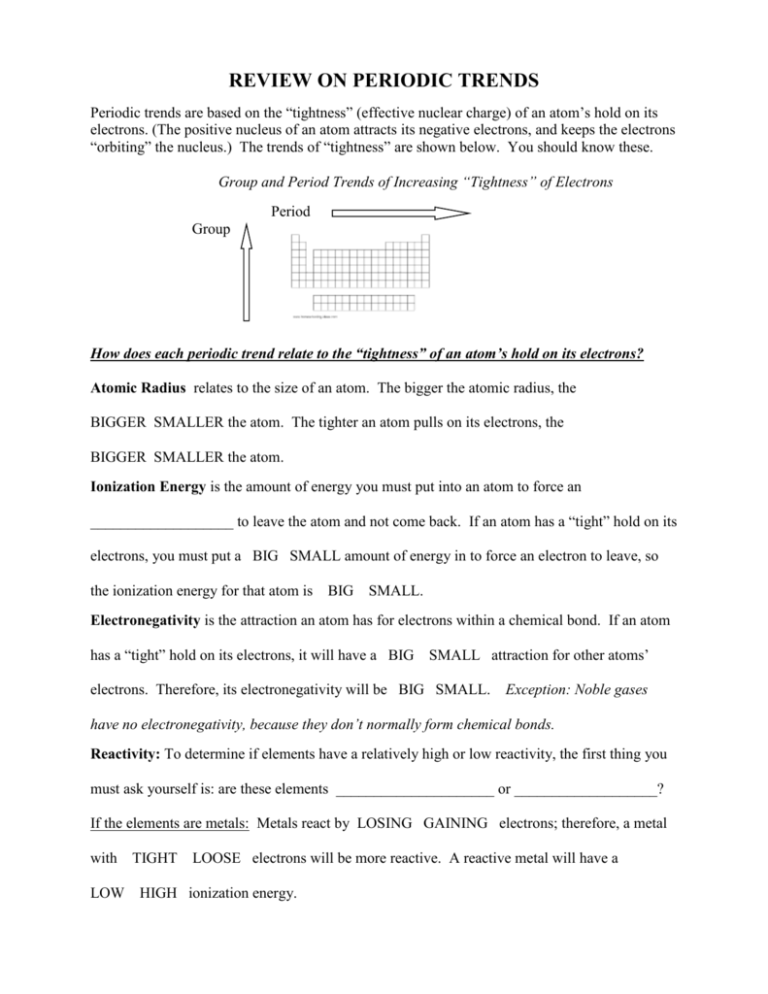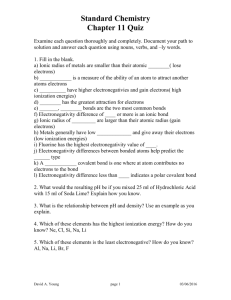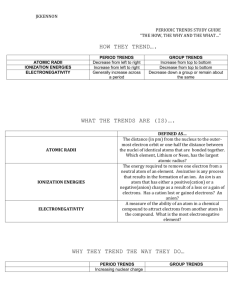answers - Bryn Mawr School Faculty Web Pages
advertisement

REVIEW ON PERIODIC TRENDS Periodic trends are based on the “tightness” (effective nuclear charge) of an atom’s hold on its electrons. (The positive nucleus of an atom attracts its negative electrons, and keeps the electrons “orbiting” the nucleus.) The trends of “tightness” are shown below. You should know these. Group and Period Trends of Increasing “Tightness” of Electrons Period Group How does each periodic trend relate to the “tightness” of an atom’s hold on its electrons? Atomic Radius relates to the size of an atom. The bigger the atomic radius, the BIGGER SMALLER the atom. The tighter an atom pulls on its electrons, the BIGGER SMALLER the atom. Ionization Energy is the amount of energy you must put into an atom to force an ___________________ to leave the atom and not come back. If an atom has a “tight” hold on its electrons, you must put a BIG SMALL amount of energy in to force an electron to leave, so the ionization energy for that atom is BIG SMALL. Electronegativity is the attraction an atom has for electrons within a chemical bond. If an atom has a “tight” hold on its electrons, it will have a BIG SMALL attraction for other atoms’ electrons. Therefore, its electronegativity will be BIG SMALL. Exception: Noble gases have no electronegativity, because they don’t normally form chemical bonds. Reactivity: To determine if elements have a relatively high or low reactivity, the first thing you must ask yourself is: are these elements _____________________ or ___________________? If the elements are metals: Metals react by LOSING GAINING electrons; therefore, a metal with LOW TIGHT LOOSE electrons will be more reactive. A reactive metal will have a HIGH ionization energy. If the elements are nonmetals: Nonmetals react by LOSING GAINING electrons; therefore a nonmetal with TIGHT LOOSE electrons will be more reactive. A reactive nonmetal will have A LOW HIGH electronegativity. Exception: Noble gases have the tightest electrons in their periods; however, they are non-reactive because they are in the lowest possible energy state. On the periodic table below, label the following: The period and group trends (increasing) for: * atomic radius * electronegativity * ionization energy The family of the * most reactive metals * most reactive nonmetals The element with the: The element that is the * “loosest” electrons * highest ionization energy * highest electronegativity * most reactive metal * least reactive elements * “tightest” electrons * lowest ionization energy * lowest electronegativity * most reactive nonmetal Practice: write the element that has the higher value for each trend ELEMENT K Ca P N Cl Ar S P Li Be TIGHTNESS OF ELECTRONS ATOMIC RADIUS IONIZATION ENERGY ELECTRONEGATIVITY REACTIVITY




